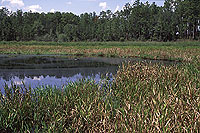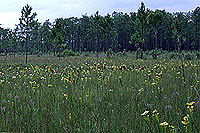|
History Animals & Plants Natural Communities Coastal Dry Uplands Upland Mesic Freshwater Marshes Forested Wetlands Fresh Water Estuaries |
Natural Communities and Habitats:
Freshwater Marshes
Freshwater Marshes: Ecologists use the word “marsh” to describe wetlands without trees, whereas “swamps” are wetlands with trees. Freshwater marshes don't cover large areas in the ARROW region except at the mouth of Apalachicola River, around Lake Wimico, on Bald Point, and fringing the impoundments on Lighthouse Road in the St. Marks Refuge. There are hundreds of little marshes scattered all over the region, however, and they serve not only as wildlife habitat, but they also store and filter stormwater runoff from highways, parking lots, and other artificial surfaces that water cannot penetrate.
You'll find freshwater marshes associated with several other natural communities: in low spots in flatwoods, on the shallow edges of lakes and rivers, and here and there in forested wetlands such as hardwood and cypress swamps, as well as on the edges of artificial bodies of water such as farm ponds, impoundments, and canals. The kind of vegetation that you find in a marsh depends on the soil, the depth of the water, and how long and how frequently it is flooded (the hydroperiod). (FWC 12)
Several subtypes of freshwater wetlands have different roles to play in the ARROW region.
 Temporary ponds with undisturbed vegetation around them are vital for many amphibian species. Here's one in the Apalachicola National Forest. (photo by Karla Brandt) |
Amphibian species known to breed and/or feed in temporary ponds are the flatwoods salamander, mole salamander, tiger salamander, dwarf salamander, striped newt, oak toad, cricket frog, pinewoods treefrog, barking treefrog, squirrel treefrog, little grass frog, southern chorus frog, ornate chorus frog, narrowmouth toad, eastern spadefoot toad, and gopher frog. Also found in temporary ponds are lots of invertebrate species, including fairy shrimps, clam shrimps, grass shrimps, and crayfishes. Typical plants in temporary ponds include St. John's wort, spikerush, yellow-eyed grass, chain fern, willows, maidencane, wax myrtle, swamp primrose, bloodroot, buttonbush, fire flag, pickerelweed, arrowheads, and bladderwort.
 Pitcherplants abound in this savannah in the western part of the Apalachicola National Forest. (photo by Karla Brandt) |
Rare animals: Henslow's sparrow, wood stork, and sandhill crane.
Rare plants: Carolina grass-of-Parnassus, large-leaved grass-of-Parnassus, St. John's black-eyed Susan
Where to see it:
Apalachee Wildlife Management Area
Apalachicola River Wildlife and Environmental Area
St. Marks National Wildlife Refuge (Lighthouse Road)
Bald Point State Park
Ochlockonee River State Park
3. Coastal freshwater and brackish marshes line the shore of East Bay in the eastern part of the Apalachicola River's delta. They contribute great quantities of tiny bits of plant material that's been processed by crabs, snails, and microscopic organisms that live on the plants and the soil. This material, called detritus, is a crucial link in the food chain that puts fish and shellfish on our plates. Typical plants are bullrush, cattail, and sawgrass where the water is fresh and cordgrass and black needlerush where it's saltier. Rare animals include diamondback terrapin and round-tailed muskrat.
Where to see it:
Apalachicola National Estuarine Research Reserve
Apalachicola River Wildlife and Environmental Area
Ochlockonee River State Park
St. Marks National Wildlife Refuge
St. Vincent National Wildlife Refuge
Note: The content of the website has not been updated since 2005. The site remains online for it's value as legacy content and is unlikely to be updated.